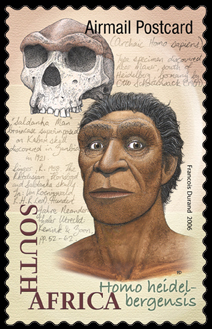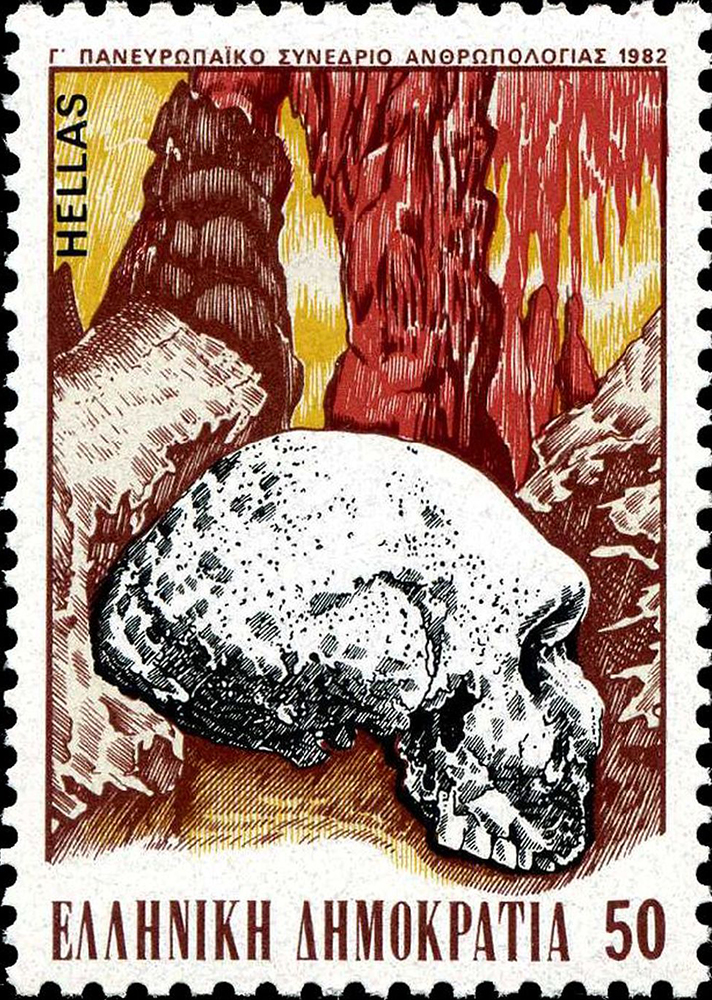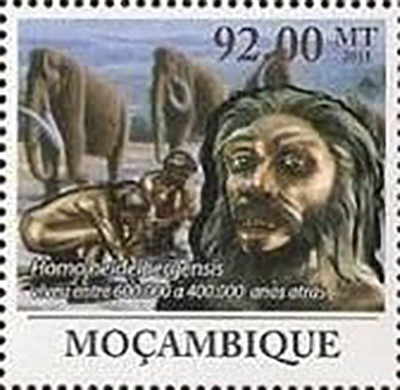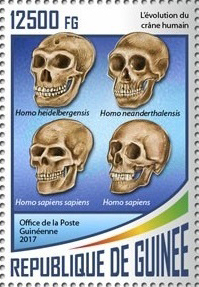Homo heidelbergensis Schoetensack, 1908

(Da: it.wikipedia.org)
Phylum: Chordata Haeckel, 1874
Classe: Mammalia Linnaeus, 1758
Ordine: Primates Linnaeus, 1758
Famiglia: Hominidae Gray, 1825
Genere: Homo Linnaeus, 1758
Descrizione
Sia l’Homo antecessor che l’Homo heidelbergensis discendono probabilmente dall’Homo ergaster, morfologicamente molto simile e proveniente dall'Africa. Tuttavia l’Homo heidelbergensis aveva una calotta cranica più allargata, con una capacità cranica di circa 1100-1200 cm³, non lontana dal valore di circa 1350 cm³ tipico per l'uomo moderno; questa differenza, assieme al comportamento e all'utilizzo di strumenti più avanzati, lo ha fatto assegnare ad una specie diversa. Questa specie, rispetto alle altre più strettamente congeneri, era di dimensioni particolarmente sviluppate: dai reperti infatti si pensa a una altezza media di circa 170 cm e ad una corporatura più massiccia per la sua epoca, pari al 90% di quella dell'uomo moderno. La morfologia dell'orecchio esterno depone per una sensibilità uditiva simile a quella degli esseri umani moderni e maggiormente complessa di quella dei suoi parenti più stretti: l’Homo heidelbergensis si ipotizza potesse distinguere molti suoni diversi.
Diffusione
Ominide estinto, vissuto fra 600 000 e 100 000 anni fa. Il nome è stato attribuito a ritrovamenti fossili precedentemente definiti come Homo sapiens arcaico, con particolare riferimento a quelli trovati in Germania presso Heidelberg, nel Baden-Württemberg, sulle rive del fiume Neckar. Altri resti sono stati trovati in Africa, Europa ed Asia occidentale.
Bibliografia
–Manzi, Giorgio (2016-08-08). "Humans of the Middle Pleistocene: The controversial calvarium from Ceprano (Italy) and its significance for the origin and variability of Homo heidelbergensis". Quaternary International. 411: 254-261.
–Hublin, J.-J. (2013), "The Middle Pleistocene Record. On the Origin of Neandertals, Modern Humans and Others" in: R. David Begun (ed.), A Companion to Paleoanthropology, John Wiley, pp. 517-537 (summary 529-531). (p. 532).
–Buck, Laura T.; Stringer, Chris B. (2014-03-17). "Homo heidelbergensis". Current Biology. 24 (6): R214-R215.
–Kjærgaard, Peter C. (2014-04-29). "Inventing Homo gardarensis: Prestige, Pressure, and Human Evolution in Interwar Scandinavia". Science in Context. 27 (2): 359-383.
–"Homo heidelbergensis (600,000 to 100,000 years ago)- Species Description". WGBH Educational Foundation and Clear Blue Sky Productions, Inc. Retrieved November 29, 2015.
–"Archaeological Site of Atapuerca". UNESCO World Heritage Centre. Retrieved November 29, 2018.
–"Homo heidelbergensis". Natural History Museum, London. Retrieved 18 March 2013.
–"Homo heidelbergensis: Evolutionary Tree information". Smithsonian National Museum of Natural History. 2010-02-14. Retrieved 18 March 2013.
–Mounier, Aurélien; Marchal, François; Condemi, Silvana (2009). "Is Homo heidelbergensis a distinct species? New insight on the Mauer mandible". Journal of Human Evolution. 56 (3): 219-46.
–"Der Homo heidelbergensis - Vor etwa 700 000 Jahren taucht der Homo heidelbergensis in Afrika auf und wandert dann über eine noch unbekannte Route ebenfalls nach Europa aus..." Homo heidelbergensis von Mauer e.V. Retrieved November 29, 2015.
–Lenton, Tim; Watson, Andrew J. (20 January 2011). Revolutions that Made the Earth. Oxford University Press. p. 364. ISBN 978-0-19-958704-9.
–Dusseldorp, Gerrit Leendert (2009). A View to a Kill: Investigating Middle Palaeolithic Subsistence Using an Optimal Foraging Perspective. Sidestone Press. p. 14. ISBN 978-90-8890-020-4.
–Minelli, Alessandro; Contrafatto, Giancarlo (10 November 2009). BIOLOGICAL SCIENCE FUNDAMENTALS AND SYSTEMATICS - Volume IV. EOLSS Publications. p. 248. ISBN 978-1-84826-189-1.
–"Prehistoric World Hominid Chronology by Peter Kessler Homo neanderthalis". Kessler Associates. July 26, 2005. Retrieved December 9, 2015.
–"What was Homo heidelbergensis? - DNA studies on both species indicate that the two were certainly distinct from each other, although related through their common Homo heidelbergensis ancestors". InnovateUs Inc. Archived from the original on December 28, 2018. Retrieved November 29, 2015.
–Meyer, Matthias; Arsuaga, Juan-Luis; de Filippo, Cesare; Nagel, Sarah; Aximu-Petri, Ayinuer; Nickel, Birgit; Martínez, Ignacio; Gracia, Ana; José; Bermúdez de Castro, María; Carbonell, Eudald; Viola, Bence; Kelso, Janet; Prüfer, Kay; Pääbo, Svante (2016). "Nuclear DNA sequences from the Middle Pleistocene Sima de los Huesos hominins". Nature. 531: 504-507.
–Ewen Callaway, "Oldest ancient-human DNA details dawn of Neanderthals" Sequence of 430,000-year-old DNA pushes back divergence of humans and Neanderthals", Nature News, 14 March 2016.
–"Homo heidelbergensis - The evolutionary dividing line between Homo erectus and modern humans was not sharp". Dennis O'Neil. Retrieved November 29, 2015.
–Lieberman, Daniel E.; McBratney, Brandeis M.; Krovitz, Gail (2002). "The evolution and development of cranial form". Proceedings of the National Academy of Sciences. 99 (3): 1134-1139.
–"100 years of Homo heidelbergensis – life and times of a controversial taxon" (PDF). Max Planck Institute for Evolutionary Anthropology. Archived from the original (PDF) on March 4, 2016. Retrieved December 9, 2015.

|
Data: 10/11/2006
Emissione: Origini dell'Umanità Stato: South Africa |
|---|

|
Data: 15/03/1982
Emissione: Congresso europeo di antropologia a Petralona (Grecia) Stato: Greece |
|---|

|
Data: 30/04/2011
Emissione: Ominidi Stato: Mozambique Nota: Emesso in un foglietto di 4 v. diversi |
|---|

|
Data: 10/10/2017
Emissione: 80esimo anniversario della morte di Charles Darwin (1809-1882) Stato: Guinea Nota: Emesso in foglietto di 4 v. diversi - Errore nel calcolo della data della morte |
|---|